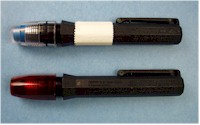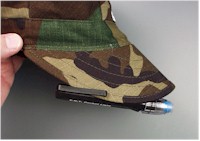|

If you carry two flashlights in the same pouch, wrap adhesive tape around
the clear lens so you can identify it at night.

Clip the penlight to your visor to free your hands.

Slip the penlight under your helmet band to free your hands.
|
Flashlights are important medical tools.
During the day, you need one for looking into the mouth, nose, eyes and
ears. At night or in dark places, you need one simply to see what you're
doing.
The headlamp that comes with the MOLLE
Medic Bag is very useful, but heavy (half a pound). The small flashlights
that come in the ENT kit and laryngoscope kit
are much lighter (1/10th of a pound) and nearly as useful. In long-term
deployments, it may be desirable to have both available.
To free your hands:
-
Clip a penlight to the visor of your cover.
-
Slide a penlight under your helmet band.
-
Hold the back of the penlight in your mouth and direct the light
where you need it.
In nighttime tactical military settings, you will use only a red light.
Some people carry a single flashlight and switch the caps from clear to
red, depending on the circumstances.
Others carry both penlight flashlights, one with a red lens, the other
with a clear lens. Wrapping a piece of adhesive tape around the flashlight
with the clear lens will enable you to identify it by feel so you don't accidentally
turn on a white light at night. Carrying two penlights also means you have
a complete backup set if a bulb burns out or batteries go dead.
Weight: 0.09 pounds
Approved for public release; Distribution is unlimited.
The listing of any non-Federal product in this CD is
not an endorsement of the product itself, but simply an acknowledgement of the
source.
Operational Medicine 2001
Health Care in Military Settings
Home ·
Military Medicine
·
Sick Call ·
Basic Exams ·
Medical Procedures
·
Lab and X-ray ·
The Pharmacy ·
The Library ·
Equipment ·
Patient Transport
·
Medical Force
Protection ·
Operational Safety ·
Operational
Settings ·
Special Operations
·
Humanitarian
Missions ·
Instructions/Orders ·
Other Agencies ·
Video Gallery ·
Phone Consultation ·
Forms ·
Web Links ·
Acknowledgements ·
Help ·
Feedback
|
Bureau of
Medicine and Surgery
Department of the Navy
2300 E Street NW
Washington, D.C
20372-5300 |
Operational
Medicine
Health Care in Military Settings
CAPT Michael John Hughey, MC, USNR
NAVMED P-5139
January 1, 2001 |
United States Special Operations Command
7701 Tampa Point Blvd.
MacDill AFB, Florida
33621-5323 |
*This web version is provided by
The Brookside Associates Medical Education
Division. It contains original contents from the official US Navy
NAVMED P-5139, but has been reformatted for web access and includes advertising
and links that were not present in the original version. This web version has
not been approved by the Department of the Navy or the Department of Defense.
The presence of any advertising on these pages does not constitute an
endorsement of that product or service by either the US Department of Defense or
the Brookside Associates. The Brookside Associates is a private organization,
not affiliated with the United States Department of Defense.
Contact Us · · Other
Brookside Products
|